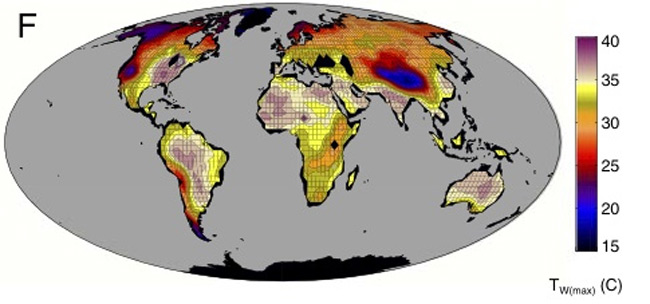Earth Could Become Too Hot for Humans

Earth's current warming trend could bring deadly heat for humans.
A new study that looked at reasonable worst-case scenarios for global warming found that if greenhouse gases continue to be emitted at their current rate, temperatures could become deadly in coming centuries.
Researchers calculated the highest tolerable "wet-bulb" temperature — equivalent to what is felt when wet skin is exposed to moving air — and found that this temperature could be exceeded for the first time in human history if greenhouse gas emissions continue at their current rate and future climate models are correct. Temperatures this unbearable for humans haven’t been seen during the existence of hominids — the primate family that includes ancient humans — but they did occur about 50 million years ago.
Exposure to wet-bulb temperatures above 95 degrees for six hours or more will create lethal stress levels in humans and other mammals, said study team member Matthew Huber of Purdue University’s earth and atmospheric sciences.
Huber said that while areas of the world regularly see temperatures above 100 degrees, really high wet-bulb temperatures are rare because the hottest areas of the planet normally have low humidity — think Arizona’s dry heat. Areas of the world such as Saudi Arabia have the highest wet-bulb temperatures near the coast where winds occasionally bring extremely hot, humid ocean air over hot land leading to unbearably stifling conditions.
"The wet-bulb limit is basically the point at which one would overheat even if they were naked in the shade, soaking wet and standing in front of a large fan," said Steven Sherwood of the Climate Change Research Centre at the University of New South Wales, Australia and the study’s lead author. "Although we are very unlikely to reach such temperatures this century, they could happen in the next."
The study did not address how likely this worst-case scenario is, only that it is possible based on so-called business-as-usual warming models, which make projections assuming that greenhouse gases continue to be emitted at the rate they are today.
Get the world’s most fascinating discoveries delivered straight to your inbox.
"We found that a warming of 12 degrees Fahrenheit (roughly 7 degrees Celsius) would cause some areas of the world to surpass the wet-bulb temperature limit, and a 21-degree warming would put half of the world's population in an uninhabitable environment," Huber said.
"Whole countries would intermittently be subject to severe heat stress requiring large-scale adaptation efforts," Huber added. "One can imagine that such efforts, for example the wider adoption of air conditioning, would cause the power requirements to soar, and the affordability of such approaches is in question for much of the Third World that would bear the brunt of these impacts. In addition, the livestock on which we rely would still be exposed, and it would make any form of outside work hazardous."
The results of the study are detailed in the May 6 issue of the journal Proceedings of the National Academy of Sciences.
- Top Ten Ways to Destroy Earth
- Earth Checkup: 10 Health Status Signs
- Reader’s Pick: Top 10 Alternative Energy Bets


